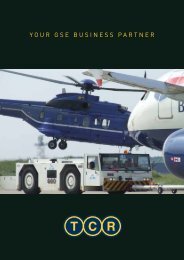WE BRING YOU SAFELY TO TAKE-OFF. - TCR Group
WE BRING YOU SAFELY TO TAKE-OFF. - TCR Group
WE BRING YOU SAFELY TO TAKE-OFF. - TCR Group
Create successful ePaper yourself
Turn your PDF publications into a flip-book with our unique Google optimized e-Paper software.
FEATURE | CARGO ULDs<br />
An Airshop container undergoes repair (above); Sweden’s Envirotainer specialises in active temperature-controlled containers (below)<br />
Container<br />
value<br />
They are not just boxes for carrying air freight – ULDs are becoming<br />
ever more sophisticated<br />
Anyone working in air freight today would be amazed at the<br />
sight of loose cargo being loaded onto an aircraft, as was the<br />
case at the birth of the industry in the early 1900s. That might<br />
have worked when only a few bags were shoved into the hold,<br />
but not anymore, as increasing air freight volumes need to be contained<br />
in a unit load device (ULD) to both maximise use of space and protect<br />
the cargo.<br />
And while most airlines rely heavily on pallets, air cargo would not<br />
exist without the huge range of containers flying around the world.<br />
There are, in fact, some 16 different container types and sizes, ranging<br />
from the most popular AKE (also known as the LD-3), which has a 4.3<br />
cubic metre capacity, to the much smaller models such as the APA/DPA<br />
(LD-2), with a 3.4 cubic metre capacity, or the giant AWC (LD-6), which<br />
has 8.9 cubic metres of space.<br />
Special containers are available for specific purposes, too. These may<br />
be walk-through, with doors at either end to allow loading from both<br />
sides; ‘flyaway’, to hold spare parts for the aircraft; transparent, to enable<br />
users to check that no goods have been left inside - ideal for carrying<br />
mail, since it is easy to leave an enveloped behind; or temperaturecontrolled,<br />
for perishable cargoes.<br />
In fact, there are so many different container types that the International<br />
Air Transport Association (IATA) has issued standards to ensure<br />
airworthiness and guidelines advising how to store, load and handle<br />
each ULD.<br />
IATA’s advice covers just about everything imaginable, including how<br />
ULDs should be stored; how they should be handled by forklifts – and<br />
how not; and how they should be marked to show their certification, or<br />
lack thereof. And that’s only a fraction of IATA’s requirements but, as it<br />
points out, the industry suffers from costly delays due to unavailability<br />
of suitable equipment and staff, the latter sometimes the result of injuries<br />
caused by improper handling of ULDs.<br />
One of the difficulties in dealing with containers is their weight.<br />
The average traditional aluminium ULD weighs between 85 and 90 kilos,<br />
which means significant fuel usage, cost and carbon emissions. The<br />
huge rise in fuel prices has encouraged airlines to look for lighter weight<br />
alternatives and manufacturers are rising to the challenge. Nordisk Aviation<br />
Products and Driessen Air Cargo Europe, the two main producers of<br />
26 AIRSIDE INTERNATIONAL | OC<strong>TO</strong>BER 2012 WWW.AIRSIDEINT.COM



